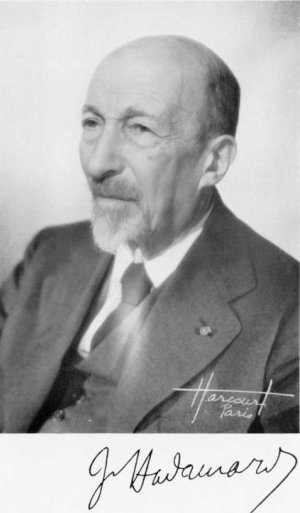<Back to Index>
- Mathematician Jacques Salomon Hadamard, 1865
- Composer Johan Julius Christian Sibelius, 1865
- Holy Roman Emperor Francis I, 1708
PAGE SPONSOR

Jacques Salomon Hadamard (December 8, 1865 – October 17, 1963) was a French mathematician who made major contributions in number theory, complex function theory, differential geometry and partial differential equations.
The son of a teacher, Amédée Hadamard, of Jewish descent, and Claire Marie Jeanne Picard, Hadamard attended the Lycée Charlemagne and Lycée Louis-le-Grand, where his father taught. In 1884 Hadamard entered the École Normale Supérieure, having been placed first in the entrance examinations both there and at the École Polytechnique. His teachers included Tannery, Hermite, Darboux, Appell, Goursat and Picard. He obtained his doctorate in 1892 and in the same year was awarded the Grand Prix des Sciences Mathématiques for his prize essay on the Riemann zeta function.
In 1892 Hadamard married Louise-Anna Trénel, also of Jewish descent, with whom he had three sons and two daughters. The following year he took up a lectureship in the University of Bordeaux, where he proved his celebrated inequality on determinants, which led to the discovery of Hadamard matrices when equality holds. In 1896 he made two important contributions: he proved the prime number theorem, using complex function theory (also proved independently by de la Vallée Poussin); and he was awarded the Bordin Prize of the French Academy of Sciences for his work on geodesics in the differential geometry of surfaces and dynamical systems. In the same year he was appointed Professor of Astronomy and Rational Mechanics in Bordeaux. His foundational work on geometry and symbolic dynamics continued in 1898 with the study of geodesics on surfaces of negative curvature. For his cumulative work, he was awarded the Prix Poncelet in 1898.
After the Dreyfus affair, which involved him personally because his wife was related to Dreyfus, Hadamard became politically active and a staunch supporter of Jewish causes though he professed to be an atheist in his religion.
In 1897 he moved back to Paris, holding positions in the Sorbonne and the Collège de France, where he was appointed Professor of Mechanics in 1909. In addition to this post, he was appointed to chairs of analysis at the École Polytechnique in 1912 and at the École Centrale in 1920, succeeding Jordan and Appell. In Paris Hadamard concentrated his interests on the problems of mathematical physics, in particular partial differential equations, the calculus of variations and the foundations of functional analysis. He introduced the idea of well-posed problem and the method of descent in the theory of partial differential equations, culminating in his seminal book on the subject, based on lectures given at Yale University in 1922. He was elected to the French Academy of Sciences in 1916, in succession to Poincaré, whose complete works he helped edit. Later in his life he wrote on probability theory and mathematical education. He was awarded the CNRS Gold medal for his lifetime achievements in 1956.
Hadamard's students included Maurice Fréchet, Paul Lévy, Szolem Mandelbrojt and André Weil. In his book Psychology of Invention in the Mathematical Field, Hadamard uses introspection to describe mathematical thought processes. In sharp contrast to authors who identify language and cognition, he describes his own mathematical thinking as largely wordless, often accompanied by mental images that
represent the entire solution to a problem. He surveyed 100 of the
leading physicists of the day (approximately 1900), asking them how
they did their work. Many of the responses mirrored his; some reported
seeing mathematical concepts as colors. Einstein reported that the
elements of his work consisted of visual and muscular entities, and
that words or language did not seem to play any role in his mechanism
of thought. Hadamard described the experiences of the mathematicians/ theoretical physicists Carl Friedrich Gauss, Hermann von Helmholtz, Henri Poincaré and others as viewing entire solutions with “sudden spontaneousness.” The same has been reported in literature by many others, such as Denis Brian, G.H. Hardy, B.L. van der Waerden, Harold Ruegg, Friedrich Kekulé (dreamed of benzene ring) and Tesla. Hadamard described the process as having four steps of the five-step Graham Wallas creative process model, with the first three also having been put forth by Helmholtz: Preparation, Incubation, Illumination, Verification.